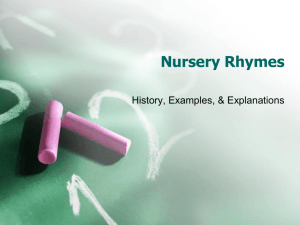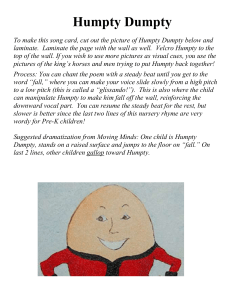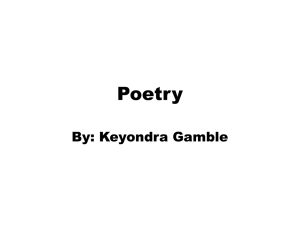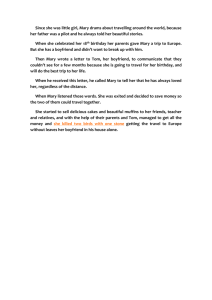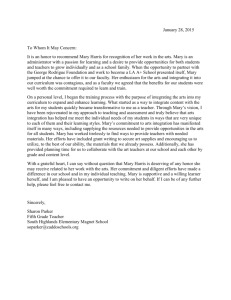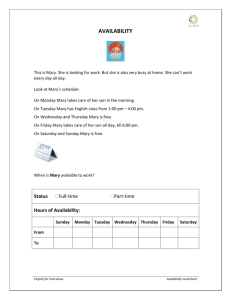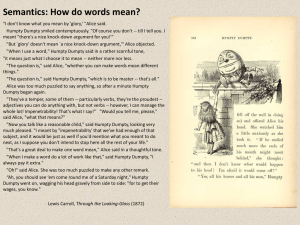Possible Origins of Some Nursery Rhymes - Latter
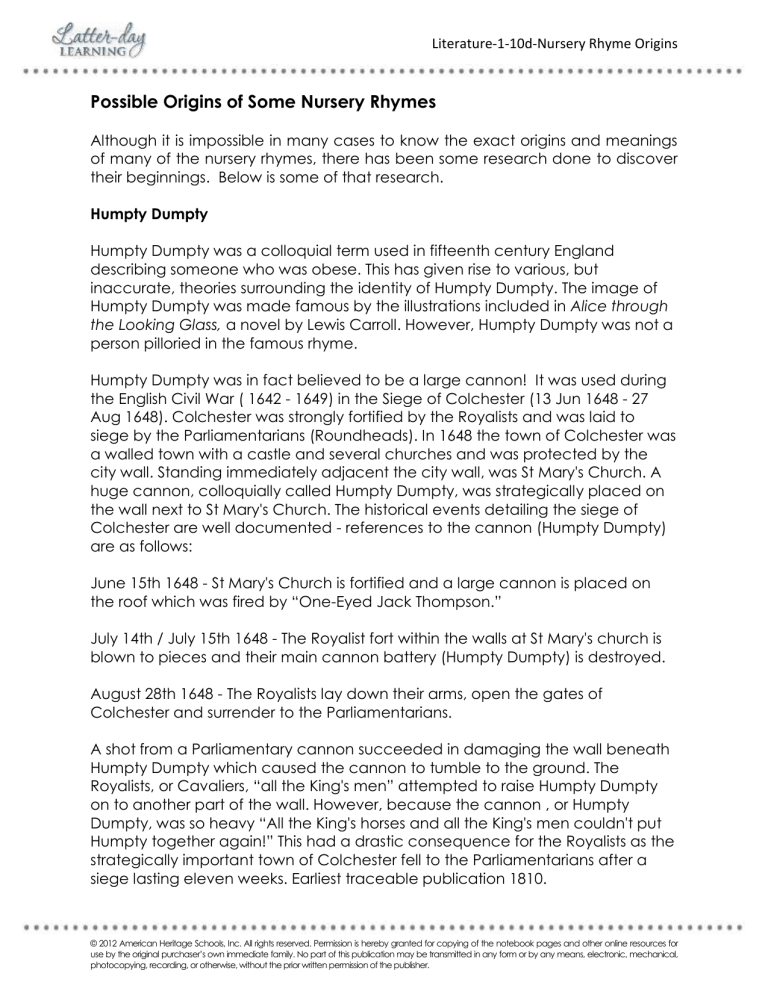
Literature-1-10d-Nursery Rhyme Origins
Possible Origins of Some Nursery Rhymes
Although it is impossible in many cases to know the exact origins and meanings of many of the nursery rhymes, there has been some research done to discover their beginnings. Below is some of that research.
Humpty Dumpty
Humpty Dumpty was a colloquial term used in fifteenth century England describing someone who was obese. This has given rise to various, but inaccurate, theories surrounding the identity of Humpty Dumpty. The image of
Humpty Dumpty was made famous by the illustrations included in Alice through
the Looking Glass, a novel by Lewis Carroll. However, Humpty Dumpty was not a person pilloried in the famous rhyme.
Humpty Dumpty was in fact believed to be a large cannon! It was used during the English Civil War ( 1642 - 1649) in the Siege of Colchester (13 Jun 1648 - 27
Aug 1648). Colchester was strongly fortified by the Royalists and was laid to siege by the Parliamentarians (Roundheads). In 1648 the town of Colchester was a walled town with a castle and several churches and was protected by the city wall. Standing immediately adjacent the city wall, was St Mary's Church. A huge cannon, colloquially called Humpty Dumpty, was strategically placed on the wall next to St Mary's Church. The historical events detailing the siege of
Colchester are well documented - references to the cannon (Humpty Dumpty) are as follows:
June 15th 1648 - St Mary's Church is fortified and a large cannon is placed on the roof which was fired by “One-Eyed Jack Thompson.”
July 14th / July 15th 1648 - The Royalist fort within the walls at St Mary's church is blown to pieces and their main cannon battery (Humpty Dumpty) is destroyed.
August 28th 1648 - The Royalists lay down their arms, open the gates of
Colchester and surrender to the Parliamentarians.
A shot from a Parliamentary cannon succeeded in damaging the wall beneath
Humpty Dumpty which caused the cannon to tumble to the ground. The
Royalists, or Cavaliers, “all the King's men” attempted to raise Humpty Dumpty on to another part of the wall. However, because the cannon , or Humpty
Dumpty, was so heavy “All the King's horses and all the King's men couldn't put
Humpty together again!” This had a drastic consequence for the Royalists as the strategically important town of Colchester fell to the Parliamentarians after a siege lasting eleven weeks. Earliest traceable publication 1810.
© 2012 American Heritage Schools, Inc. All rights reserved. Permission is hereby granted for copying of the notebook pages and other online resources for use by the original purchaser’s own immediate family. No part of this publication may be transmitted in any form or by any means, electronic, mechanical, photocopying, recording, or otherwise, without the prior written permission of the publisher.
Literature-1-10d-Nursery Rhyme Origins http://www.rhymes.org.uk/humpty_dumpty.htm
A quick reading of Humpty Dumpty shows that at no point does it ever mention that Humpty Dumpty is an egg. Some believe that’s because “humpty dumpty” was actually a new type of cannon used in the English Civil War, only to shatter when first lit. Others, however, believe the term refers to a type of brandy or a clumsy person, which together gives you “fall down drunk.” Of course, the fact that horses would be called upon to solder a military weapon back together or perform surgery on a problem drinker’s shattered spine tells us all we really need to know about Old England’s vocational and medical schools’ lax admissions policies. http://www.smosh.com/smosh-pit/articles/actual-true-meanings-classic-nurseryrhymes
Mary Had a Little Lamb
The song “Mary Had a Little Lamb” is an American nursery rhyme.
The words were written by Sarah Hale, of Boston, in 1830. There is an interesting historical note about this rhyme. The words of Mary had a Little Lamb were the first ever recorded by Thomas Edison, on tin foil, on his phonograph. http://www.rhymes.org.uk/mary_had_a_little_lamb.htm
Mary, Mary, Quite Contrary
The origins of this nursery rhyme are steeped in history... Bloody Mary.
The Mary alluded to in this traditional English nursery rhyme is reputed to be Mary
Tudor, or Bloody Mary, who was the daughter of King Henry VIII. Queen Mary was a staunch Catholic and the garden referred to is an allusion to graveyards which were increasing in size with those who dared to continue to adhere to the
Protestant faith—Protestant martyrs.
Instruments of Torture:
The silver bells and cockle shells referred to in the Nursery Rhyme were colloquialisms for instruments of torture.
The "Pretty Maids all in a row" or Maiden was the original guillotine. The 'maids' were a device to behead people called the Maiden. Beheading a victim was fraught with problems. It could take up to 11 blows to actually sever the head.
The victim often resisted and had to be chased around the scaffold. Margaret
Pole (1473 - 1541), Countess of Salisbury did not go willingly to her death and had to be chased and hacked at by the Executioner. These problems led to the
© 2012 American Heritage Schools, Inc. All rights reserved. Permission is hereby granted for copying of the notebook pages and other online resources for use by the original purchaser’s own immediate family. No part of this publication may be transmitted in any form or by any means, electronic, mechanical, photocopying, recording, or otherwise, without the prior written permission of the publisher.
Literature-1-10d-Nursery Rhyme Origins invention of a mechanical instrument (now known as the guillotine) called the
Maiden—shortened to Maids in the Mary, Mary Nursery Rhyme. The Maiden had long been in use in England before Lord Morton, regent of Scotland during the minority of James VI, had a copy constructed from the Maiden which had been used in Halifax in Yorkshire. Ironically, Lord Morton fell from favor and was the first to experience the Maiden in Scotland.
Another form of execution during Mary's reign was being burnt at the stake—a terrible punishment much used during the Spanish Inquisition. The English hated the Spanish and dreaded the idea of an Inquisition. The executions during the reign of Bloody Mary were therefore viewed with a greater fear of the Spanish than the executions themselves—It is interesting to note that executions during her reign totalled less than 300, an insignificant amount compared to the executions ordered by her father King Henry VIII, which are believed to have numbered in the tens of thousands. http://www.rhymes.org.uk/mary_mary_quite_contrary.htm
Mary, Mary, Quite Contrary has been seen as having religious and historical significance, but its origins and meaning are disputed as is often the case. The most common interpretation identifies “Mary” with Mary I of England. The “How does your garden grow?” may make mocking reference to her womb and the fact that she gave birth to no heirs, or to the common idea that England had become a Catholic vassal or “branch” of Spain and the Habsburgs, or may even be a punning reference to her chief minister, Stephen Gardiner
(“gardener”). “Quite contrary” could be a reference to her attempt to reverse ecclesiastical changes made by her father Henry VIII and her brother Edward VI.
The “pretty maids all in a row” could be a reference to miscarriages or her execution of Lady Jane Grey. Capitalizing on the Queen’s portrayal by Whig historians as “Bloody Mary,” the “silver bells and cockle shells” could be colloquialisms for instruments of torture. http://listverse.com/2009/08/19/10-nursery-rhymes-and-their-origins/
There was an Old Woman Who Lived in a Shoe
At first glance the words to "There was an old woman" would appear to be nonsense, but in fact it is believed to have origins in English history.
There are two choices of origin:
The first relates to Queen Caroline (There was an old woman) wife of King
George II who had eight children.
© 2012 American Heritage Schools, Inc. All rights reserved. Permission is hereby granted for copying of the notebook pages and other online resources for use by the original purchaser’s own immediate family. No part of this publication may be transmitted in any form or by any means, electronic, mechanical, photocopying, recording, or otherwise, without the prior written permission of the publisher.
Literature-1-10d-Nursery Rhyme Origins
The second version refers to King George who began the men's fashion for wearing white powdered wigs. He was consequently referred to as the old woman. The children were the members of parliament and the bed was the
Houses of Parliament—even today the term 'whip' is used in the English
Parliament to describe a member of Parliament who is tasked to ensure that all members “toe the party line.” As a point of historical interest the wigs worn by women of the period were so large and unhygienic that it became necessary to include mousetraps in their construction. http://www.rhymes.org.uk/there_was_an_old_woman.htm
Twinkle Twinkle Little Star
The beautiful words of “Twinkle Twinkle Little Star” have been immortalized in the poem and music has been added, thus increasing its popularity. The simile “like a diamond in the sky” teaches children how words can be used to paint a picture in the imagination. The words create a comparison between the twinkling of the star to a sparkling diamond thus providing a perfect illustration of clever imagery and excellent use of the English language. The joint authors of
“Twinkle Twinkle Little Star” were two sisters called Ann Taylor (1782-1866) and
Jane Taylor (1783-1824).
The first publication date was 1806. http://www.rhymes.org.uk/twinkle_twinkle_little_star.htm
© 2012 American Heritage Schools, Inc. All rights reserved. Permission is hereby granted for copying of the notebook pages and other online resources for use by the original purchaser’s own immediate family. No part of this publication may be transmitted in any form or by any means, electronic, mechanical, photocopying, recording, or otherwise, without the prior written permission of the publisher.
